The exact solution of the composite fractional differential equation
IF 5.6
1区 数学
Q1 MATHEMATICS, INTERDISCIPLINARY APPLICATIONS
引用次数: 0
Abstract
The result of the fractional derivative of a function which is the fractional differential equation, has been used to describe many physical phenomena such as composite fractional oscillation equation (CFOE), as it provides memory and hereditary properties of the CFOE. The solution of the CFOE is essential and is at the interest of every researcher. The numerical methods used in obtaining the solution of the CFOE are prone to errors and are time-consuming in terms of the number of iterations before the desired solution is obtained. However, the analytic methods provide the exact solution to the CFOE and additionally, serves as a benchmark for which numerical solution of the CFOE is compared to obtain reliable and good approximated solution. Surprisingly, no researcher has ever applied analytic method to obtain the exact solution of the CFOE. In this paper, both the Homotopy Analysis Method (HAM) and the Variational Iteration Method (VIM) are used to obtain the exact solution of the CFOE in a suitable functional space. In using the HAM, it is flexible to choose the value of the convergence control parameter to adjust the emanated series from the CFOE to converge to the exact solution. On the other hand, the VIM is endowed with the Lagrangian multiplier which facilitates the convergence of emanated series from the CFOE to the exact solution. In addition, it is established in this paper that the use of HAM requires fewer iterations for the series emanating from the CFOE to converge to the exact solution as compared with the use of VIM. With this observation, the HAM is easier and more efficient to use as compared with the VIM.
复合分数阶微分方程的精确解
一个函数的分数阶导数的结果即分数阶微分方程,已经被用来描述许多物理现象,如复合分数阶振荡方程(CFOE),因为它提供了CFOE的记忆和遗传特性。CFOE的解决方案是至关重要的,并且符合每个研究人员的利益。用于求解CFOE的数值方法容易出现误差,并且在获得所需解之前的迭代次数非常耗时。然而,解析方法提供了CFOE的精确解,并作为比较CFOE数值解的基准,以获得可靠的、良好的近似解。令人惊讶的是,至今还没有研究者应用解析方法来获得CFOE的精确解。本文采用同伦分析法(HAM)和变分迭代法(VIM)在合适的泛函空间中求出CFOE的精确解。在使用HAM时,可以灵活地选择收敛控制参数的值来调整CFOE的发射序列,使其收敛到精确解。另一方面,VIM被赋予拉格朗日乘子,使得发散级数从CFOE收敛到精确解。此外,本文还证明了与使用VIM相比,使用HAM可以减少从CFOE发出的序列收敛到精确解的迭代次数。通过这种观察,与VIM相比,HAM更容易和更有效地使用。
本文章由计算机程序翻译,如有差异,请以英文原文为准。
求助全文
约1分钟内获得全文
求助全文
来源期刊

Chaos Solitons & Fractals
物理-数学跨学科应用
CiteScore
13.20
自引率
10.30%
发文量
1087
审稿时长
9 months
期刊介绍:
Chaos, Solitons & Fractals strives to establish itself as a premier journal in the interdisciplinary realm of Nonlinear Science, Non-equilibrium, and Complex Phenomena. It welcomes submissions covering a broad spectrum of topics within this field, including dynamics, non-equilibrium processes in physics, chemistry, and geophysics, complex matter and networks, mathematical models, computational biology, applications to quantum and mesoscopic phenomena, fluctuations and random processes, self-organization, and social phenomena.
 求助内容:
求助内容: 应助结果提醒方式:
应助结果提醒方式:


